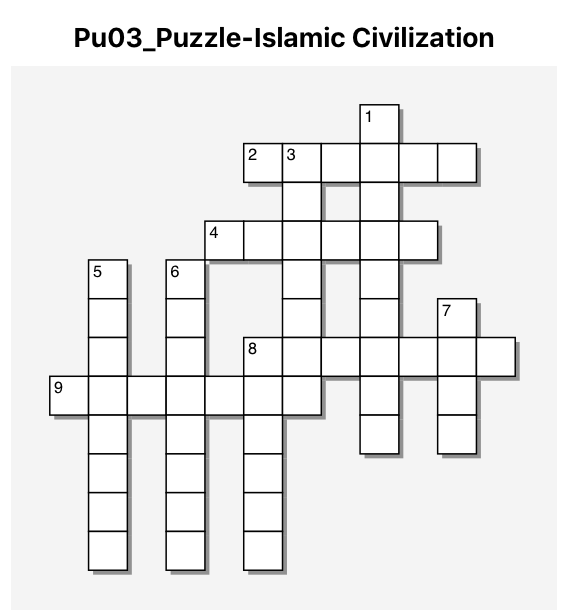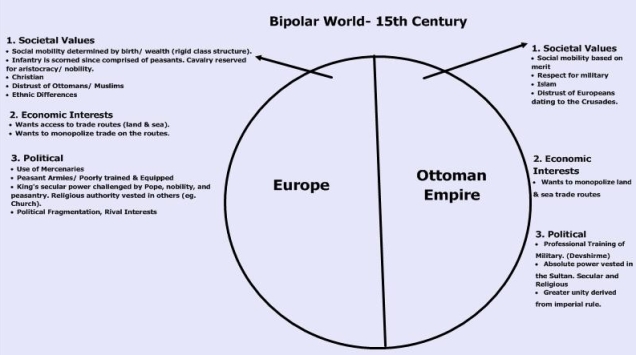Pr03a2_No Dark Age in Islamic World (Slide by Slide Description)
The accompanying presentation to this slide by slide description can be accessed by clicking the link above.
Cover Slide: The Bismillah (“In the Name of Allah, the Most Gracious, Most Merciful”). The opening phrase to all the chapters (Sura) of the Qur-an, except for one (9th). It is also uttered before special occasions. The slide shows a beautiful rendition of Arabic calligraphy. Calligraphy is a tool to elevate text to a visual beauty while the text also maintains it’s literal beauty.
Slide #2: Map of the Islamic Empire. The Prophet dies in AD 632 (born AD 570), but not before he was able to unite the peoples of the Arabian peninsula. Each succeeding Caliphate expands upon the initial political success of the rising Islamic Civilization. The map is color-coded to show how each caliphate (Orthodox and Umayyad) extended the reach of the civilization. A great benefit of this map is that it’s easy to see how Jewish and Christian peoples diffuse with the advancing Arabs. The Byzantine Empire in the North is the greatest Christian presence in the region. The final caliphate (Abbasid, AD 750) is not shown since the expansion has predominantly halted and begins a gradual decline thereafter.
Slide #3: This slide reinforces the oft repeated statement of the power of cultural diffusion and commercial activity. Wherever the merchant goes, there goes the ideas of his society. Wherever contact is made, there is transferred the ideas. North Africa, as most of the ancient world, had contact with Arab merchants.
Slide #4: This graphic is great to contextualize size and the “bridging” role played by the Islamic Civilization. This empire connected East with West. Trade traversed the length of this empire and carried ideas far beyond their place of origin.
Slide #5: The Abbasid Caliphate is commonly associated with the Golden Age of Islamic Civilization. It’s achievement in the Arts and Sciences did not reflect it’s declining political influence. This map shows how the empire is contracting under the weight of rebellious provincial governors and external incursions (Fatamid Emirate of Iberia, The Frankish Kingdom of Western Europe, and the Turks of Central Asia).
Slide #6: The list of literary accomplishments is long and this slide only touches upon a small fraction. The Qur-an is accepted as the highest poetic form in the Arabic language. When one recites a verse from it, its as if the person is singing. 1001 Arabian Nights has achieved global recognition and still entertains people today despite it’s age. Calligraphy and the poems of Omar Khayyam elevate the written word to a state of beauty, beyond the ordinary role of conveying information.
Slide #7: Architecturally, the Islamic Civilization was able to assimilate the ideas of others (Rome’s arch) and modify/ transport them to ends of their empire (Spain- Alhumbra/ South Asia- Taj Mahal).
Slide #8: The mastery of navigation (for trade) and organize time (for prayers and rituals) turned the Islamic Culture into one of Math and Science. The requirement to read the Qur-an made the population literate (comparatively). Contact with the Indian Subcontinent expose the Arab merchant to numerals that are then carried throughout the empire. These numerals, erroneously, are known as Arabic Numerals. South Asia also contributes knowledge about the viral nature of illnesses and the tools that can combat it (Syringes).
Slide #9: Lastly, here are examples of pottery and rugs that sport the same visual beauty that adorns Arabic text. The religious prohibition to depict images of people also encourages experimentation with other artistic forms (Calligraphy, geometric shapes).

